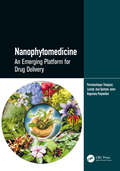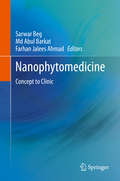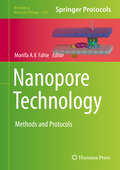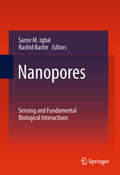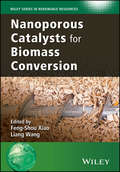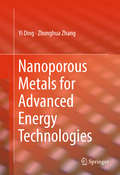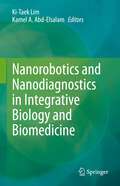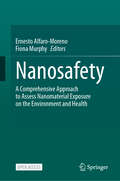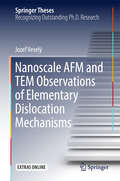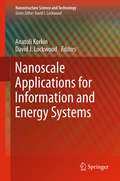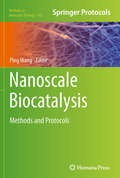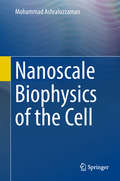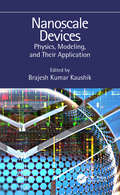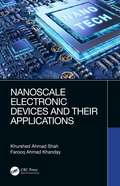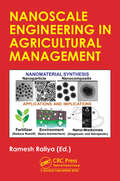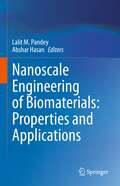- Table View
- List View
Nanophytomedicine: An Emerging Platform for Drug Delivery
by Parimelazhagan Thangaraj Lucindo Jose Quintans Junior N. PonpandianNanophytomedicine is a branch of medicine that involves the application of nanomedicine-based systems to phytotherapy and phytopharmacology and the use of phytonanoparticles for biomedical applications. Nanophytomedicine covers recent advances in experimental and theoretical studies on various properties of nanoparticles derived from plant sources. This book assesses the recent advancements and applications of plant-based nanoparticles and also highlights emerging concepts of biomimetics. The book contains 24 chapters encompassing various therapeutic applications of phytochemicals derived from plants, ferns, seaweeds, and so on, mediated through nanotechnology and its allied approaches. A fervent attempt has been made to compile every significant advancement in the field of phytonanomedicine so as to accelerate its momentum in the pharmaceutical sector.
Nanophytomedicine: Concept to Clinic
by Sarwar Beg Farhan Jalees Ahmad Md Abul BarkatNanophytomedicine is a field that involves the application of nanomedicine-based systems to phytotherapy and phytopharmacology. This book assesses the clinical successes and failures of nanophytomedicine and also highlights emerging concepts in this field. The content is divided into three sections, the first of which describes core issues in the pharmaceuticals industry in connection with the successes, failures and prospects of nanophytomedicine. The second section highlights recent advances in phytomedicine formulation development based on nanotechnology approaches, while also discussing a variety of nanocarrier systems for the successful delivery of phytomedicines. Focusing on the clinical perspective, the third section addresses the current clinical status of nanophytomedicine as a single drug therapy or combinatorial drug therapy, pharmacovigilance, pharmacokinetics, drug interactions and toxicological profiles, while also providing concluding remarks on recent experimental findings, and considering ethical issues & regulatory challenges in nanophytomedicine. Given its scope, the book offers a valuable guide for early career researchers, young scientists, master level students, academics and industrial scientists working in various healthcare fields, e.g. the pharmaceutical and biological sciences, life sciences, biotechnology, biomedical engineering, and nanobiotechnology.
Nanophytopathology
by Mahendra Rai Graciela Avila-QuezadaThe book entitled ‘Nanophytopathology’ discusses the need for alternative technologies particularly smart nanotechnological tools including nanobiosensor in the detection of plant diseases, delivery of fungicides/pesticides, and therapy for the diseases caused by plant pathogens and pests. The use of nanomaterials will minimize the huge amount of application of pesticides and fungicides thereby reducing environmental pollution. This technology is eco-friendly, economically viable, and useful for sustainable crop production. The book encompasses chapters written by experienced experts in respective fields, which provide up-to-date knowledge about pathogen/pest control using nanotechnology. It will be essential reading for post-graduate students and researchers, agriculture scientists, nanotechnologists, microbiologists, green chemistry experts, and biotechnologists.
Nanoplasmonic Sensors
by Alexandre DmitrievThis book is a compendium of the finest research in nanoplasmonic sensing done around the world in the last decade. It describes basic theoretical considerations of nanoplasmons in the dielectric environment, gives examples of the multitude of applications of nanoplasmonics in biomedical and chemical sensing, and provides an overview of future trends in optical and non-optical nanoplasmonic sensing. Specifically, readers are guided through both the fundamentals and the latest research in the two major fields nanoplasmonic sensing is applied to - bio- and chemo-sensing - then given the state-of-the-art recipes used in nanoplasmonic sensing research.
Nanopore Technology: Methods and Protocols (Methods in Molecular Biology #2186)
by Monifa A. V. FahieThis detailed collection explores techniques involved in the main strategies of nanopore sensing, such as translocation, analyte trapping, and interactions with external binding sites. Opening with a section on nanopore design and nanopore production, the book continues with parts devoted to various biological nanopores, nanopore engineering, and their uses in single molecule sensing, computational methods to study intrinsic nanopore behavior, characterizing the specific translocation activity of a vesicle particle through a nanopore, as well as the use of the technique droplet interface bilayer (DIB) in nanopore and membrane biophysical studies. Written for the highly successful Methods in Molecular Biology series, chapters include introductions to their respective topics, lists of the necessary materials and reagents, step-by-step, readily reproducible laboratory protocols, and tips on troubleshooting and avoiding known pitfalls. Authoritative and practical, Nanopore Technology: Methods and Protocols, with its focus on nanopore technology and biomolecule characterization, will hold the interest of the biophysicists, biochemists, bioengineers, and molecular biologists who are working toward further understanding this key field of research.
Nanopore-Based Technology
by Maria E. GrachevaNanopores are vital biological features, described as tiny holes in cellular membranes used for recognition and transport of ions and molecules between compartments within the cell, as well as between the extracellular environment and the cell itself. Their study, ever growing in esteem, leads toward the promise of ultra-fast sequencing of DNA molecules with the ultimate goal of building a nanoscale device that will make rapid and cheap DNA sequencing a reality. In Nanopore-Based Technology, expert researchers in the forefront of the field explore the cutting-edge of nanopore technology for single molecule sensing, detection, and characterization. Divided into four convenient parts, this volume covers single molecule characterization techniques utilizing biological pores, methods for biomolecule characterization with nanoporous artificial membranes, computational studies of the biomolecule confined within the nanopore environment, as well as techniques that use novel materials in conjunction with nanopore sensing. Written for the highly successful Methods in Molecular BiologyTM series, this work provides the kind of detailed description and implementation advice that is crucial for achieving optimal results. Authoritative and state-of-the-art, Nanopore-Based Technology serves as an excellent representation of the present-day available techniques for biomolecule characterization with nanoporous membranes in order to guide researchers toward developing the next generation of technologies for fast and cheap DNA sequencing with practically no limitations on the read lengths.
Nanopores
by Rashid Bashir Samir M. IqbalNanopores are nanometer scale holes formed naturally by proteins or cells, and can be used for a variety of applications, including sequencing DNA and detecting anthrax. They can be integrated into artificially constructed encapsulated cells of silicon wafers while allowing small molecules like oxygen, glucose and insulin to pass, while keeping out large system molecules. "Nanopores: Sensing and Fundamental Biological Interactions" examines the emerging research directions surrounding nanopores such as genome sequencing and early disease detection using biomarker identification. Covering the applications of nanopores in genetics, proteomics, drug discovery, early disease detection and detection of emerging environmental threats, it is a must-have book for biomedicalengineers and research scientists.
Nanoporous Carbons for Soft and Flexible Energy Devices (Carbon Materials: Chemistry and Physics #11)
by Francesca Borghi Francesca Soavi Paolo MilaniThis book provides an interesting snapshot of new research within the fields of flexible and soft devices which use porous carbon-based materials. The increase in demand for soft and flexible electronics, electrochemical energy storage/conversion systems, piezoresistive pressure sensors has promoted the development of new strategies for the synthesis and integration of nanoporous carbon (NPC) into flexible and soft polymers and inorganic textures. The structural properties of such NPC materials combined with their mechanical, conductive and catalytic properties, show promising results for the technology they are designed for, which can be useful solutions in many other disciplines. An in-depth discussion of the use of NPC materials in different energy devices is provided in every chapter, while at the same time the knowledge of the reader on the various applications where these materials can be used will be broadened. This book sheds new light on nanoporous carbon-based materials and will be of great interest to graduate students and professionals working in this field.
Nanoporous Catalysts for Biomass Conversion
by Liang Wang Christian V. Stevens Feng-Shou XiaoA comprehensive introduction to the design, synthesis, characterization, and catalytic properties of nanoporous catalysts for the biomass conversion With the specter of peak oil demand looming on the horizon, and mounting concerns over the environmental impact of greenhouse gas emissions, biomass has taken on a prominent role as a sustainable alternative fuel source. One critical aspect of the biomass challenge is the development of novel catalytic materials for effective and controllable biomass conversion. Edited by two scientists recognized internationally for their pioneering work in the field, this book focuses on nanoporous catalysts, the most promising class of catalytic materials for the conversion of biomass into fuel and other products. Although various catalysts have been used in the conversion of biomass-derived feedstocks, nanoporous catalysts exhibit high catalytic activities and/or unique product selectivities due to their large surface area, open nanopores, and highly dispersed active sites. This book covers an array of nanoporous catalysts currently in use for biomass conversion, including resins, metal oxides, carbons, mesoporous silicates, polydivinylbenzene, and zeolites. The authors summarize the design, synthesis, characterization and catalytic properties of these nanoporous catalysts for biomass conversions, discussing the features of these catalysts and considering future opportunities for developing more efficient catalysts. Topics covered include: Resins for biomass conversion Supported metal oxides/sulfides for biomass oxidation and hydrogenation Nanoporous metal oxides Ordered mesoporous silica-based catalysts Sulfonated carbon catalysts Porous polydivinylbenzene Aluminosilicate zeolites for bio-oil upgrading Rice straw Hydrogenation for sugar conversion Lignin depolymerization Timely, authoritative, and comprehensive, Nanoporous Catalysts for Biomass Conversion is a valuable working resource for academic researchers, industrial scientists and graduate students working in the fields of biomass conversion, catalysis, materials science, green and sustainable chemistry, and chemical/process engineering.
Nanoporous Materials: Advanced Techniques for Characterization, Modeling, and Processing
by Nick KanellopoulosHaving successfully replaced elements used in traditional, pollution-prone, energy-consuming separation processes, nanoporous materials play an important role in chemical processing. Although their unique structural or surface physicochemical properties can, to an extent, be tailored to meet specific process-related requirements, the task of charac
Nanoporous Materials: Synthesis and Applications
by Qiang XuIn the past two decades, the field of nanoporous materials has undergone significant developments. As these materials possess high specific surface areas, well-defined pore sizes, and functional sites, they show a great diversity of applications such as molecular adsorption/storage and separation, sensing, catalysis, energy storage and conversion,
Nanoporous Metals for Advanced Energy Technologies
by Yi Ding Zhonghua ZhangThis book covers the state-of-the-art research in nanoporous metals for potential applications in advanced energy fields, including proton exchange membrane fuel cells, Li batteries (Li ion, Li-S, and Li-O2), and supercapacitors. The related structural design and performance of nanoporous metals as well as possible mechanisms and challenges are fully addressed. The formation mechanisms of nanoporous metals during dealloying, the microstructures of nanoporous metals and characterization methods, as well as miscrostructural regulation of nanoporous metals through alloy design of precursors and surface diffusion control are also covered in detail. This is an ideal book for researchers, engineers, graduate students, and government/industry officers who are in charge of R&D investments and strategy related to energy technologies.
Nanoproteomics
by Steven A. Toms Robert J. WeilAs two relatively new fields of study, proteomics and nanotechnology have developed in parallel with each other to allow an increased precision in the identification of post-translational protein modifications as well as to provide a more automated isolation and detection of rare proteins in both serum and tissues. The Nanoproteomics: Methods and Protocols volume organizes and collects technical advances from leaders in the field to make laboratory protocols more readily available and understandable to those who are attempting to incorporate nanotechnologic techniques into their proteomic research. Conveniently divided into five sections, this detailed volume covers preliminary sample preparation, nanoscale fluidic devices and methods, nanostructured surfaces and nanomaterials, and nanoproteomic techniques to detect and understand protein and proteomic alterations specific to human pathology. Written in the highly successful series entitled Methods in Molecular BiologyTM, these chapters include introductions to their respective topics, lists of the necessary materials and reagents, step-by-step laboratory protocols that are readily reproducible, and tips on troubleshooting and avoiding known pitfalls. Convenient and authoritative, Nanoproteomics: Methods and Protocols offers key procedures that are culled from the laboratories of leaders in the field of nanoproteomics with the aim of helping researchers in their standardization and proliferation of protocols that will lead to a more wide scale adoption and smoother progress in this vital field.
Nanorobotics and Nanodiagnostics in Integrative Biology and Biomedicine
by Kamel A. Abd-Elsalam Ki-Taek LimNanorobotics and Nanodiagnostics in Integrative Biology and Biomedicine "Nanorobotics and nanodiagnostics” can be defined as a new generation of biohybrid and nanorobotics that translate fundamental biological principles into engineering design rules, or integrative living components into synthetic structures to create biorobots and nanodiagnotics that perform like natural systems. Nanorobots or nanobots are structured of a nanoscale made of individual assemblies. They can be termed as intelligent systems manufactured with self-assembly strategies by chemical, physical and biological approaches. The nanorobot can determine the structure and enhance the adaptability to the environment in interdisciplinary tasks."Nanorobotics and nanodiagnostics" is a new generation of biohybrid that translates fundamental biological principles into engineering design rules to create biorobots that perform like natural systems. These biorobotics and diagnostics can now perform various missions to be accomplished certain tasks in the research areas such as integrative biology and biomedicine. "Nanorobotics and Nanodiagnostics in Integrative Biology and Biomedicine" sheds light on a comprehensive overview of the multidisciplinary areas that explore nanotherapeutics and nanorobotic manipulation in biology and medicine. It provides up-to-date knowledge of the promising fields of integrative biology and biomedicine for nano-assisted biorobotics and diagnostics to detect and treat diseases that will enable new scientific discoveries.
Nanosafety: A Comprehensive Approach to Assess Nanomaterial Exposure on the Environment and Health
by Fiona Murphy Ernesto Alfaro-MorenoNanosafety encompasses a spectrum of multidisciplinary studies, including nanotoxicology, immunotoxicology, genotoxicity, and epigenetic effects. Nanomaterials, with their unique properties and diverse applications, have revolutionized industries from medicine to electronics. However, the potential risks associated with their use demand meticulous investigation and understanding. This open access book serves as a crucial resource, bridging the gap between the burgeoning field of nanotechnology and the imperative need to ensure the safety of nanomaterials in various contexts. As nanotechnology continues to transform our world, this book provides invaluable insights and guidance for researchers, policymakers, and industries, ensuring the responsible and safe development of nanomaterials and their applications in the 21st century.
Nanoscale AFM and TEM Observations of Elementary Dislocation Mechanisms
by Jozef VeselýThis thesis addresses elementary dislocation processes occurring in single-crystalline alloys based on Fe-Al, and investigates correspondences between dislocation distribution inside crystals characterized by transmission electron microscopy (TEM) and surface patterns observed using atomic force microscopy (AFM). Fe-Al alloys with different degrees of ordering were prepared and deformed in compression at ambient temperature in-situ inside the AFM device. The evolution of slip line structures was captured in the sequences of AFM images and wavy slip bands, while cross slip at the tip of the slip band and homogeneous fine slip lines were also identified. Further, the thesis develops a technique for constructing 3D representations of dislocations observed by TEM without the prohibitive difficulties of tomography, and creates 3D models of dislocation structures. Generally speaking, the thesis finds good agreement between AFM and TEM observations, confirming the value of AFM as a relevant tool for studying dislocations.
Nanoscale Applications for Information and Energy Systems
by Anatoli Korkin David J. LockwoodNanoscale Applications for Information and Energy Systems presents nanotechnology fundamentals and applications in the key research areas of information technology (electronics and photonics) and alternative (solar) energy: plasmonics, photovoltaics, transparent conducting electrodes, silicon electroplating, and resistive switching. The three major technology areas - electronics, photonics, and solar energy - are linked on the basis of similar applications of nanostructured materials in research and development. By bridging the materials physics and chemistry at the atomic scale with device and system design, integration, and performance requirements, tutorial chapters from worldwide leaders in the field provide a coherent picture of theoretical and experimental research efforts and technology development in these highly interdisciplinary areas.
Nanoscale Biocatalysis
by Ping WangNanoscale science and engineering, which deal with size-dependent properties and phenomenon at nanometer scale, are unveiling new mechanisms that scientists must rely on heavily at the present time to achieve efficient and sustainable chemical processing technologies. In Nanoscale Biocatalysis: Methods and Protocols, expert researchers in the field contribute detailed methodologies and procedures that have been developed from recent research in this burgeoning area of nanoscale technology-enabled biocatalysis. The volume opens with concepts in preparing unique and dynamic protein structures for biocatalysis, then moves on to cover methods for preparation of enzyme assembles or complexes that maintain molecular-like Brownian mobility, the development of protein-nanostructure complexes using carbon nanotubes (CNTs) and nanoparticles, as well as methodologies that have great potential for scale-up preparation of nano-structured biocatalysts. Written in the highly successful Methods in Molecular BiologyTM series format, chapters include brief introductions to their respective topics, lists of the necessary materials and reagents, step-by-step, readily reproducible laboratory protocols, and vital tips on troubleshooting and avoiding known pitfalls. Authoritative and cutting-edge, Nanoscale Biocatalysis: Methods and Protocols is an ideal guide to the new wave of development in nearly all the major areas of science and engineering brought about by this fascinating and greatly promising area of study.
Nanoscale Biophysics of the Cell
by Mohammad AshrafuzzamanMacroscopic cellular structures and functions are generally investigated using biological and biochemical approaches. But these methods are no longer adequate when one needs to penetrate deep into the small-scale structures and understand their functions. The cell is found to hold various physical structures, molecular machines, and processes that require physical and mathematical approaches to understand and indeed manipulate them. Disorders in general cellular compartments, perturbations in single molecular structures, drug distribution therein, and target specific drug-binding, etc. are mostly physical phenomena. This book will show how biophysics has revolutionized our way of addressing the science and technology of nanoscale structures of cells, and also describes the potential for manipulating the events that occur in them.
Nanoscale Devices: Physics, Modeling, and Their Application
by Brajesh Kumar KaushikThe primary aim of this book is to discuss various aspects of nanoscale device design and their applications including transport mechanism, modeling, and circuit applications. . Provides a platform for modeling and analysis of state-of-the-art devices in nanoscale regime, reviews issues related to optimizing the sub-nanometer device performance and addresses simulation aspect and/or fabrication process of devices Also, includes design problems at the end of each chapter
Nanoscale Electrochemistry of Molecular Contacts (SpringerBriefs in Applied Sciences and Technology)
by Paulo Roberto BuenoThis book discusses the merging of nanoscale electronics and electrochemistry and how this can potentially modernize the way electronic devices are currently engineered or constructed. It introduces the electrochemical capacitance as a fundamental missing concept that solves the puzzle between molecular electronics and electrochemistry at the nanoscale. The electrochemical capacitance, as a fundamental principle, is deduced from first principles quantum mechanics. The text also confirmed that faradaic and non-faradaic processes are only different physical approximations of the same sort of energetic phenomenon.The book comprises three chapters. Chapter one introduces the concepts of chemical capacitance, relaxation resistance, and the quantum resistive-capacitive circuit and demonstrates how these elements are translated to the electrochemistry context. In chapter two, the chemical capacitance, the fundamental concept and missing part of the puzzle that unity electronics and electrochemistry, is deduced from first principles of quantum mechanics. In chapter three, the concepts are practically used in different contexts that include molecular diagnostics, molecular conductance and super-capacitive phenomena is explained using the introduced basic principles.
Nanoscale Electronic Devices and Their Applications
by Khurshed Ahmad Shah Farooq Ahmad KhandayNanoscale Electronic Devices and Their Applications helps readers acquire a thorough understanding of the fundamentals of solids at the nanoscale level in addition to their applications including operation and properties of recent nanoscale devices. This book includes seven chapters that give an overview of electrons in solids, carbon nanotube devices and their applications, doping techniques, construction and operational details of channel-engineered MOSFETs, and spintronic devices and their applications. Structural and operational features of phase-change memory (PCM), memristor, and resistive random-access memory (ReRAM) are also discussed. In addition, some applications of these phase-change devices to logic designs have been presented. Aimed at senior undergraduate students in electrical engineering, micro-electronics engineering, physics, and device physics, this book: Covers a wide area of nanoscale devices while explaining the fundamental physics in these devices Reviews information on CNT two- and three-probe devices, spintronic devices, CNT interconnects, CNT memories, and NDR in CNT FETs Discusses spin-controlled devices and their applications, multi-material devices, and gates in addition to phase-change devices Includes rigorous mathematical derivations of the semiconductor physics Illustrates major concepts thorough discussions and various diagrams
Nanoscale Engineering in Agricultural Management
by Ramesh RaliyaAgriculture plays a vital role in our lives, providing food and economic benefits. Today, it faces severe challenges, due to decreasing arable land, depleting natural resources, changing climate pattern, and yet increasing demand for food. The recent introduction of nanotechnology in agriculture offers sustainable and precise solutions for developing smart agriculture practices and addressing the challenges faced by the ag-sector. Therefore, it is essential to understand this new science from a multidimensional perspective. Experts in the field have contributed in putting together this volume, covering topics like plant growth, protection and management using engineering nanoscale materials. The chapters in the book have been peer-reviewed and selected for publication based on independent reviewers’ reports. The book covers very specific, in-depth, and fundamental and applied aspects of the latest ag-nanotechnology research. It is hoped that each chapter of the book will be very useful for researchers, policy makers, and other audiences from interdisciplinary scientific subjects.
Nanoscale Engineering of Biomaterials: Properties and Applications
by Lalit M. Pandey Abshar HasanThis book provides a comprehensive overview of the latest advances in a wide range of biomaterials for the development of smart and advanced functional materials. It discusses the fundamentals of bio-interfacial interactions and the surface engineering of emerging biomaterials like metals and alloys, polymers, ceramics, and composites/nanocomposites. In turn, the book addresses the latest techniques and approaches to engineering material surfaces/interfaces in, e.g., implants, tissue engineering, drug delivery, antifouling, and dentistry. Lastly, it summarizes various challenges in the design and development of novel biomaterials. Given its scope, it offers a valuable source of information for students, academics, physicians and particularly researchers from diverse disciplines such as material science and engineering, polymer engineering, biotechnology, bioengineering, chemistry, chemical engineering, nanotechnology, and biomedical engineering for various commercial and scientific applications.
Nanoscale Ferroelectrics and Multiferroics: Key Processing and Characterization Issues, and Nanoscale Effects
by Miguel Alguero J. Marty Gregg Liliana MitoseriuThis book reviews the key issues in processing and characterization of nanoscale ferroelectrics and multiferroics, and provides a comprehensive description of their properties, with an emphasis in differentiating size effects of extrinsic ones like boundary or interface effects. Recently described nanoscale novel phenomena are also addressed. Organized into three parts it addresses key issues in processing (nanostructuring), characterization (of the nanostructured materials) and nanoscale effects. Taking full advantage of the synergies between nanoscale ferroelectrics and multiferroics, it covers materials nanostructured at all levels, from ceramic technologies like ferroelectric nanopowders, bulk nanostructured ceramics and thick films, and magnetoelectric nanocomposites, to thin films, either polycrystalline layer heterostructures or epitaxial systems, and to nanoscale free standing objects with specific geometries, such as nanowires and tubes at different levels of development. The book is developed from the high level European scientific knowledge platform built within the COST (European Cooperation in Science and Technology) Action on Single and multiphase ferroics and multiferroics with restricted geometries (SIMUFER, ref. MP0904). Chapter contributors have been carefully selected, and have all made major contributions to knowledge of the respective topics, and overall, they are among most respected scientists in the field.
